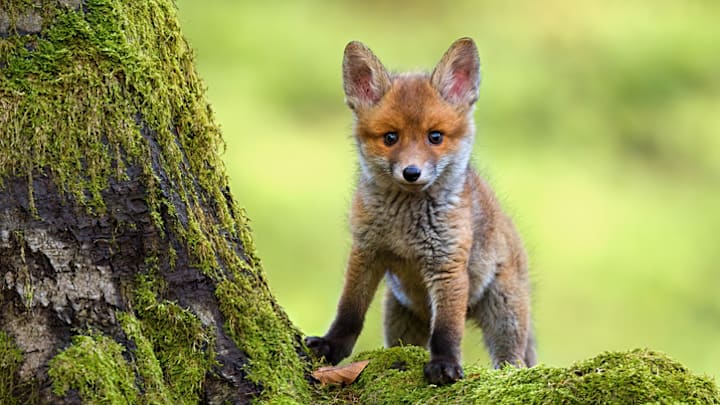There are 12 species of true foxes, likely evolved from a common ancestor and belonging to the genus Vulpes. And each one has babies so cute that your average kawaii character looks like Gollum by comparison.
All adult true foxes, including the spectacular square-skulled Tibetan sand fox, breed in monogamous pairs and raise the young together. Baby foxes are most often called “kits,” but they're also known as cubs, pups, or whelps. Here are few facts that will make you want to squeeze one right now.
- Baby foxes are altricial.
- Red fox kits are born with gray fur and blue eyes.
- Arctic foxes have the largest litters of any carnivore.
- Bat-eared fox moms don’t regurgitate food for their kits.
- Fennec fox babies have floppy ears.
- Some kit fox kits can’t wait to leave home.
- Fox kits on their own aren’t necessarily in trouble.
- Wildlife rehabilitators wear fox outfits to care for rescued kits.
Baby foxes are altricial.
Precociality and altriciality are fancy words that describe an animal’s state at birth. Precocial young are able to move, eat, and fend for themselves moments after they’re born, while altricial young are basically helpless and depend on their parents for a period of time. Baby foxes are in the latter group: They are born with closed eyes and no teeth and require constant care until they can leave their den. But even after the babies are weaned, both parents will bring food back to them, sometimes regurgitating or tearing it up for easy digestion. They might also give them live prey to “play” with so they learn hunting skills [PDF].
Red fox kits are born with gray fur and blue eyes.
When red foxes (Vulpes vulpes) are born, the melanin in their cells is not fully developed, resulting a darker coats and light eyes. Within a couple of weeks their fur changes color to reddish-brown and their eyes turn from blue to amber.
Arctic foxes have the largest litters of any carnivore.
Though the average number of kits varies among populations of Arctic foxes (Vulpes lagopus), researchers have reported a pair of Arctic foxes having a litter of 19 babies. They’re born in underground dens, which are sometimes the enlarged burrows of ground squirrels. Some Arctic fox families use the same den for several generations.
Bat-eared fox moms don’t regurgitate food for their kits.
The bat-eared fox (Otocyon megalotis) of eastern and southern Africa is named for its resemblance to many of those winged creatures of the night. Their gigantic ears allow them to hear the movements of insects—which is all they eat—if the prey is underground or otherwise hidden. They can even hear beetle larvae hatching inside balls of dung. Their insectivorous diet isn’t easy for the bat-eared babies to digest, so mothers don’t regurgitate their meals for them.
Fennec fox babies have floppy ears.
Adult fennec foxes (Vulpes zerda), which live in the deserts of North Africa and the Arabian peninsula, are the smallest species of true fox with one of the animal kingdom’s largest ear-to-body size ratios. Fennec fox kits’ ears don’t seem so huge—in fact, they’re small and floppy, given the tiny animals a lamb-like appearance. By the time they’re a month old and emerging from their den for the first time, they already have a very good start on those trademark ears, which will help them shed body heat and hear the rustling of prey like insects, lizards, and rodents.
Some kit fox kits can’t wait to leave home.
There are fox kits and then there are kit foxes (Vulpes macrotis), North America’s smallest fox species. They lives in scrublands and deserts across the Southwest and California. Kits belonging to one subspecies, the San Joaquin kit fox, strike out on their own at about 4 to 5 months old. They will move up to 60 miles away from their natal den, but their habitats have been drastically altered and fragmented by development, drought, and other changes, making dispersal difficult. They were designated as endangered in 1967 [PDF].
Fox kits on their own aren’t necessarily in trouble.
If you happen to see fox kits alone, they aren’t necessarily abandoned. The parents are usually close and keeping an eye on their brood. Fox moms also maintain several dens at a time and will move their kits one by one to new locations. But they’ll shy away from their babies if people are nearby or they can smell human scent. If you find a kit alone, and its eyes are open, it’s best to leave it where it is.
Wildlife rehabilitators wear fox outfits to care for rescued kits.
If a kit has been left a lone for longer than two hours or its eyes are still closed, a local wildlife rehabilitator should be called for a rescue. That’s where the costumes come in. Melissa Stanley, the founder of the Richmond Wildlife Center in Virginia, wore a furry, slightly terrifying red fox mask to treat an abandoned kit so it wouldn’t come to associate humans with food and care. Animal caregivers specializing in pandas and whooping cranes have worn costumes for the same reason. Sometimes the animal people are almost as cute as the animals.
Discover More Fascinating Facts About Foxes:
